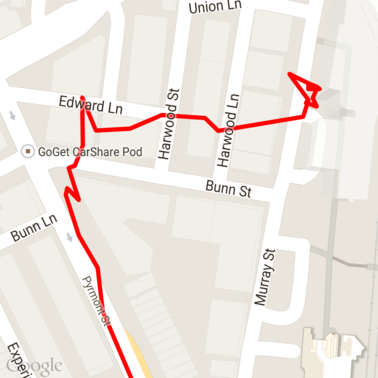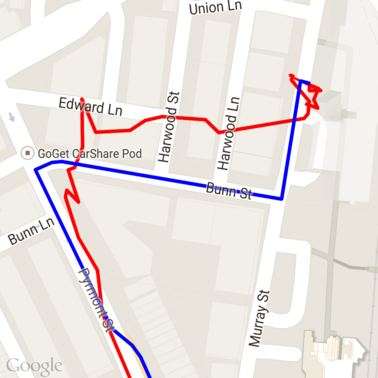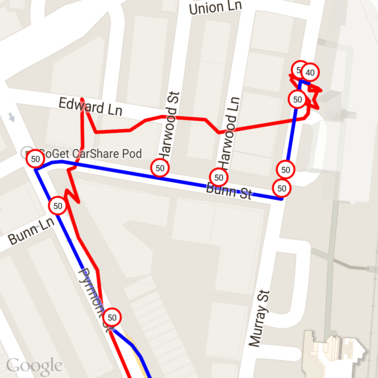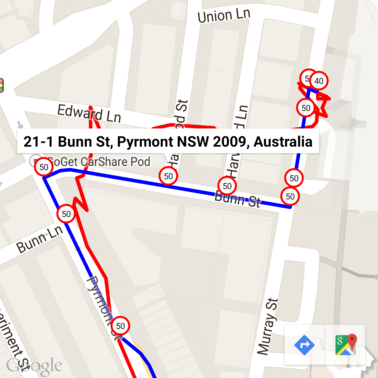তথ্য সংগ্রহ করুন
সংগৃহীত অবস্থানের তথ্য সংগ্রহের অনেক উপায় আছে। এখানে আমরা Roads API এর স্ন্যাপ টু রোডস বৈশিষ্ট্যের সাথে ডেটা অর্জনের দুটি কৌশল বর্ণনা করব।
জিপিএক্স
GPX হল একটি উন্মুক্ত XML-ভিত্তিক ফর্ম্যাট যা GPS ডিভাইস দ্বারা ক্যাপচার করা রুট, ট্র্যাক এবং ওয়েপয়েন্ট শেয়ার করার জন্য। এই উদাহরণে XmlPull পার্সার ব্যবহার করা হয়েছে, যা জাভা সার্ভার এবং মোবাইল উভয় পরিবেশের জন্য উপলব্ধ একটি হালকা XML পার্সার।
/** * Parses the waypoint (wpt tags) data into native objects from a GPX stream. */ private List<LatLng> loadGpxData(XmlPullParser parser, InputStream gpxIn) throws XmlPullParserException, IOException { // We use a List<> as we need subList for paging later List<LatLng> latLngs = new ArrayList<>(); parser.setInput(gpxIn, null); parser.nextTag(); while (parser.next() != XmlPullParser.END_DOCUMENT) { if (parser.getEventType() != XmlPullParser.START_TAG) { continue; } if (parser.getName().equals("wpt")) { // Save the discovered latitude/longitude attributes in each <wpt>. latLngs.add(new LatLng( Double.valueOf(parser.getAttributeValue(null, "lat")), Double.valueOf(parser.getAttributeValue(null, "lon")))); } // Otherwise, skip irrelevant data } return latLngs; }
এখানে কিছু কাঁচা GPX ডেটা একটি মানচিত্রে লোড করা আছে।

অ্যান্ড্রয়েড লোকেশন পরিষেবা
অ্যান্ড্রয়েড ডিভাইস থেকে জিপিএস ডেটা ক্যাপচার করার সর্বোত্তম উপায় আপনার ব্যবহারের ক্ষেত্রের উপর নির্ভর করে। অবস্থান আপডেট গ্রহণের উপর অ্যান্ড্রয়েড প্রশিক্ষণ ক্লাস, এবং গিটহাবের গুগল প্লে অবস্থান নমুনাগুলি একবার দেখুন।
দীর্ঘ পথ প্রক্রিয়া করুন
যেহেতু স্ন্যাপ টু রোডস বৈশিষ্ট্যটি পৃথক পয়েন্টের পরিবর্তে সম্পূর্ণ পাথের উপর ভিত্তি করে অবস্থান নির্ধারণ করে, তাই দীর্ঘ পাথগুলি (অর্থাৎ, প্রতি অনুরোধের সীমা 100-পয়েন্টের বেশি পাথ) প্রক্রিয়া করার সময় আপনাকে যত্নবান হতে হবে।
পৃথক অনুরোধগুলিকে একটি দীর্ঘ পথ হিসেবে বিবেচনা করার জন্য, আপনার কিছু ওভারল্যাপ অন্তর্ভুক্ত করা উচিত, যাতে পূর্ববর্তী অনুরোধের শেষ পয়েন্টগুলি পরবর্তী অনুরোধের প্রথম পয়েন্ট হিসাবে অন্তর্ভুক্ত করা হয়। অন্তর্ভুক্ত করার পয়েন্টের সংখ্যা আপনার ডেটার নির্ভুলতার উপর নির্ভর করে। কম নির্ভুলতার অনুরোধের জন্য আপনার আরও পয়েন্ট অন্তর্ভুক্ত করা উচিত।
এই উদাহরণটি গুগল ম্যাপস সার্ভিসেসের জন্য জাভা ক্লায়েন্ট ব্যবহার করে পৃষ্ঠাযুক্ত অনুরোধ পাঠায় এবং তারপর ইন্টারপোলেটেড পয়েন্ট সহ ডেটা পুনরায় ফেরত তালিকায় যুক্ত করে।
/** * Snaps the points to their most likely position on roads using the Roads API. */ private List<SnappedPoint> snapToRoads(GeoApiContext context) throws Exception { List<SnappedPoint> snappedPoints = new ArrayList<>(); int offset = 0; while (offset < mCapturedLocations.size()) { // Calculate which points to include in this request. We can't exceed the API's // maximum and we want to ensure some overlap so the API can infer a good location for // the first few points in each request. if (offset > 0) { offset -= PAGINATION_OVERLAP; // Rewind to include some previous points. } int lowerBound = offset; int upperBound = Math.min(offset + PAGE_SIZE_LIMIT, mCapturedLocations.size()); // Get the data we need for this page. LatLng[] page = mCapturedLocations .subList(lowerBound, upperBound) .toArray(new LatLng[upperBound - lowerBound]); // Perform the request. Because we have interpolate=true, we will get extra data points // between our originally requested path. To ensure we can concatenate these points, we // only start adding once we've hit the first new point (that is, skip the overlap). SnappedPoint[] points = RoadsApi.snapToRoads(context, true, page).await(); boolean passedOverlap = false; for (SnappedPoint point : points) { if (offset == 0 || point.originalIndex >= PAGINATION_OVERLAP - 1) { passedOverlap = true; } if (passedOverlap) { snappedPoints.add(point); } } offset = upperBound; } return snappedPoints; }
স্ন্যাপ টু রোডস রিকোয়েস্ট চালানোর পর উপরে থেকে পাওয়া ডেটা এখানে। লাল লাইনটি হল কাঁচা ডেটা এবং নীল লাইনটি হল স্ন্যাপ করা ডেটা।

কোটার দক্ষ ব্যবহার
স্ন্যাপ টু রোডস অনুরোধের প্রতিক্রিয়ায় স্থান আইডির একটি তালিকা অন্তর্ভুক্ত থাকে যা আপনার প্রদত্ত পয়েন্টগুলির সাথে ম্যাপ করে, যদি আপনি interpolate=true সেট করেন তবে অতিরিক্ত পয়েন্ট সহ সম্ভাব্য।
গতি সীমা অনুরোধের জন্য আপনার অনুমোদিত কোটার দক্ষতার সাথে ব্যবহার করার জন্য, আপনার অনুরোধে শুধুমাত্র অনন্য স্থান আইডিগুলির জন্য অনুসন্ধান করা উচিত। এই উদাহরণে স্থান আইডিগুলির তালিকা থেকে গতি সীমা অনুসন্ধান করার জন্য Google মানচিত্র পরিষেবাগুলির জন্য জাভা ক্লায়েন্ট ব্যবহার করা হয়েছে।
/** * Retrieves speed limits for the previously-snapped points. This method is efficient in terms * of quota usage as it will only query for unique places. * * Note: Speed limit data is only available for requests using an API key enabled for a * Google Maps APIs Premium Plan license. */ private Map<String, SpeedLimit> getSpeedLimits(GeoApiContext context, List<SnappedPoint> points) throws Exception { Map<String, SpeedLimit> placeSpeeds = new HashMap<>(); // Pro tip: Save on quota by filtering to unique place IDs. for (SnappedPoint point : points) { placeSpeeds.put(point.placeId, null); } String[] uniquePlaceIds = placeSpeeds.keySet().toArray(new String[placeSpeeds.keySet().size()]); // Loop through the places, one page (API request) at a time. for (int i = 0; i < uniquePlaceIds.length; i += PAGE_SIZE_LIMIT) { String[] page = Arrays.copyOfRange(uniquePlaceIds, i, Math.min(i + PAGE_SIZE_LIMIT, uniquePlaceIds.length)); // Execute! SpeedLimit[] placeLimits = RoadsApi.speedLimits(context, page).await(); for (SpeedLimit sl : placeLimits) { placeSpeeds.put(sl.placeId, sl); } } return placeSpeeds; }
প্রতিটি অনন্য স্থান আইডিতে গতি সীমা চিহ্নিত করে উপরে থেকে তথ্য এখানে দেওয়া হল।

অন্যান্য API-এর সাথে ইন্টারপ্লে করুন
স্ন্যাপ টু রোড রেসপন্সে প্লেস আইডি ফেরত দেওয়ার একটি সুবিধা হল, আপনি অনেক গুগল ম্যাপস প্ল্যাটফর্ম এপিআই তে প্লেস আইডি ব্যবহার করতে পারেন। এই উদাহরণে জাভা ক্লায়েন্ট ফর গুগল ম্যাপস সার্ভিসেস ব্যবহার করে উপরের স্ন্যাপ টু রোড রিকোয়েস্ট থেকে ফিরে আসা প্লেস জিওকোড করা হয়।
/** * Geocodes a snapped point using the place ID. */ private GeocodingResult geocodeSnappedPoint(GeoApiContext context, SnappedPoint point) throws Exception { GeocodingResult[] results = GeocodingApi.newRequest(context) .place(point.placeId) .await(); if (results.length > 0) { return results[0]; } return null; }
এখানে গতিসীমা চিহ্নিতকারীটি জিওকোডিং API থেকে ঠিকানা দিয়ে টীকা করা হয়েছে।

নমুনা কোড
বিবেচনা
এই ডকুমেন্টটি সমর্থনকারী কোডটি উদাহরণ হিসেবে একটি একক অ্যান্ড্রয়েড অ্যাপ হিসেবে উপলব্ধ। বাস্তবে আপনার সার্ভার-সাইড API কীগুলি একটি অ্যান্ড্রয়েড অ্যাপে বিতরণ করা উচিত নয় কারণ আপনার কীটি তৃতীয় পক্ষের অননুমোদিত অ্যাক্সেস থেকে সুরক্ষিত করা যাবে না। পরিবর্তে, আপনার কীগুলি সুরক্ষিত করার জন্য আপনাকে API-মুখী কোডটি একটি সার্ভার-সাইড প্রক্সি হিসাবে স্থাপন করতে হবে এবং আপনার অ্যান্ড্রয়েড অ্যাপকে প্রক্সি ব্যবহার করে অনুরোধ পাঠাতে হবে, যাতে অনুরোধগুলি অনুমোদিত হয় তা নিশ্চিত করা যায়।
ডাউনলোড করুন
GitHub থেকে কোডটি ডাউনলোড করুন।

